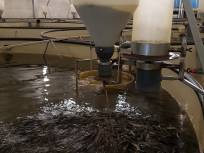Feeding of the fish is one of the most important activities in the fish farm. Underfeeding results in a depression of the growth, overfeeding results in water pollution and waste of expensive feed. Proper feeding strongly affects the growth of the fish, as well as the food conversions that can be achieved.
Feeding can be done by hand, but this can be time consuming, especially when large numbers of tanks must be dealt with, or when there are many meals per day. Because of this ACE developed several types of automatic feeding systems.
Each fish tank is equipped with a feed dispenser. In some cases, we use demand- or pendulum feeders, that allow the fish to take feed by themselves when they feel hungry. In most cases automatic feeders are used. ACE developed several types of feed dispensers, ranging from screw feeders to pneumatic feeders. The choice depends on the species that is grown, the feed that is used, and the set-up of the farm system.
Each feed dispenser is controlled by a computer, that is pre-programmed with the growth curve and feeding tables. The operator enters stocking data, mortalities as well as management choices such as the number of meals per day. The computer calculates the meal sizes and administers the feed accordingly. Feed rations can be adjusted up or down manually by the operator depending on the actual appetite of the fish.
The computer program stores the data for each tank, as well as predictions of the growth, biomass, fish numbers and feed gifts for each tank. These data can be used to give early warning for a disease outbreak, predict what fish will be market ready soon or to calculate the realized feed conversion of a batch of fish after harvesting.




